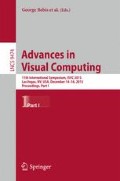Abstract
We present Aperio - an interactive real-time system for visualizing complex organic-shaped 3D models such as anatomy data or medical data. Aperio employs an interaction model based on a mechanical tool analogy via a small set of virtual “metal” tools, such as rods, rings, cutters, and scalpels. The familiar and well-differentiated tool shapes, combined with their initial pose and metallic appearance, suggest a tool’s function to the user. Cutter tools are designed to create easily-understood cutaway views, and rings and rods provide simple oriented path constraints that support rigid transformations of models via “sliding”, including interactive exploded view capabilities. GPU rendering provides realistic real-time “solid cut” previewing of surface-mesh models. We demonstrate Aperio using a human anatomy data set and present user studies to provide supporting evidence of Aperio’s interaction simplicity and its effectiveness for visualizing model spatial interrelationships.
Access this chapter
Tax calculation will be finalised at checkout
Purchases are for personal use only
Notes
- 1.
A video of Aperio can be viewed at www.youtube.com/watch?v=KcGfVjDlnpU.
- 2.
It is not necessary to draw completely across the selected object.
- 3.
If a selected model is not penetrated, a point on the rod closest to the center of the model’s OBB is used.
- 4.
We also initially used a separate system with a simplified user interface, similar to the interface of common object modeling packages, as a control for the study but it was found to be too simplistic and was rated poorly by almost all users. The results for this simplified system are not included in this paper but can be found in [15].
References
Elmqvist, N., Tsigas, P.: A taxonomy of 3d occlusion management for visualization. IEEE Trans. Visual Comput. Graphics 14, 1095–1109 (2008)
Knödel, S., Hachet, M., Guitton, P.: Interactive generation and modification of cutaway illustrations for polygonal models. In: Butz, A., Fisher, B., Christie, M., Krüger, A., Olivier, P., Therón, R. (eds.) SG 2009. LNCS, vol. 5531, pp. 140–151. Springer, Heidelberg (2009)
Li, W., Ritter, L., Agrawala, M., Curless, B., Salesin, D.: Interactive cutaway illustrations of complex 3d models. ACM Trans. Graph. 26, 31:1–31:11 (2007)
McInerney, T., Crawford, P.: RibbonView: interactive context-preserving cutaways of anatomical surface meshes. In: Bebis, G., et al. (eds.) ISVC 2010, Part II. LNCS, vol. 6454, pp. 533–544. Springer, Heidelberg (2010)
Pindat, C., Pietriga, E., Chapuis, O., Puech, C.: Drilling into complex 3d models with gimlenses. In: VRST 2013, pp. 223–230 (2013)
Trapp, M., Döllner, J.: 2.5d clip-surfaces for technical visualization. J. WSCG 21, 89–96 (2013)
Burns, M., Finkelstein, A.: Adaptive cutaways for comprehensible rendering of polygonal scenes. ACM Trans. Graph. 27, 154:1–154:7 (2008)
Sonnet, H., Carpendale, S., Strothotte, T.: Integrating expanding annotations with a 3d explosion probe. In: Proceedings of the Working Conference on Advanced Visual Interfaces, AVI 2004, pp. 63–70. ACM, New York (2004)
Tatzgern, M., Kalkofen, D., Schmalstieg, D.: Compact explosion diagrams. In: Proceedings of the 8th International Symposium on Non-photorealistic Animation and Rendering, NPAR 2010. ACM, New York, pp. 17–26 (2010)
Li, W., Agrawala, M., Curless, B., Salesin, D.: Automated generation of interactive 3d exploded view diagrams. ACM Trans. Graph. 27, 101:1–101:7 (2008)
Bruckner, S., Gröller, M.E.: Exploded views for volume data. IEEE Trans. Visual Comput. Graphics 12, 1077–1084 (2006)
Birkeland, S., Viola, I.: View-dependent peel-away visualization for volumetric data. In: Hauser, H., Spencer, S.N. (eds.) Spring Conference on Computer Graphics SCCG, pp. 121–128. ACM (2009)
Correa, C.D., Silver, D., Chen, M.: Feature aligned volume manipulation for illustration and visualization. IEEE Trans. Vis. Comput. Graph. 12, 1069–1076 (2006)
McGuffin, M.J., Tancau, L., Balakrishnan, R.: Using deformations for browsing volumetric data. In: Proceedings of the 14th IEEE Visualization 2003 (VIS 2003), p. 53. IEEE Computer Society, Washington, D.C. (2003)
Tran, D.: Aperio: Managing 3d scene occlusion using a mechanical analogy for visualizing multi-part mesh data. Master’s thesis, Dept. of Computer Science, Ryerson University, Toronto, ON, Canada (2015)
Schroeder, W.J., Martin, K., Lorensen, W.: The Visualization Toolkit: An Object-Oriented Approach to 3d Graphics, 4th edn. Kitware Inc., Clifton (2006)
Barr, A.H.: Superquadrics and angle-preserving transformations. IEEE Comput. Graph. Appl. 1, 11–23 (1981)
SurveyMonkey Inc.: SurveyMonkey. www.surveymonkey.com. Accessed 08 October 2015
Author information
Authors and Affiliations
Corresponding author
Editor information
Editors and Affiliations
Rights and permissions
Copyright information
© 2015 Springer International Publishing Switzerland
About this paper
Cite this paper
McInerney, T., Tran, D. (2015). Aperio: A System for Visualizing 3D Anatomy Data Using Virtual Mechanical Tools. In: Bebis, G., et al. Advances in Visual Computing. ISVC 2015. Lecture Notes in Computer Science(), vol 9474. Springer, Cham. https://doi.org/10.1007/978-3-319-27857-5_71
Download citation
DOI: https://doi.org/10.1007/978-3-319-27857-5_71
Published:
Publisher Name: Springer, Cham
Print ISBN: 978-3-319-27856-8
Online ISBN: 978-3-319-27857-5
eBook Packages: Computer ScienceComputer Science (R0)

